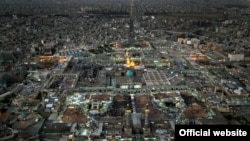The Minister of Roads and Urban development has bitterly criticized the “balloon-like growth” of Mashhad, the largest city in Northeast Iran, while a city official has lambasted a religious foundation (Astan-e Qods Razavi) for taking over and owning 43% of the total area of the city.
Abbas Akhoundi; a Najaf born London educated member of President Hassan Rouhani’s cabinet; is deeply unhappy with the enlargement of Shi’a’s most sacred city inside Iran and its population growth, Daily Sharq reported on Monday, September 11.
“When the Comprehensive Plan of Mashhad was endorsed in 1995, it was expected to limit the area of the city to 22,000 hectares (roughly 85 square miles) and its population to 1,800,000 people”, lamented Akhoundi.
However, the Minister added, “today, the area of the city has reached 31,000 hectares (roughly 120 square miles) and its population to three million”.
From this growth, 5,000 hectares is nothing but neighborhoods with rundown and dilapidated texture, Akhoundi maintains. He adds that nationwide, 19 million people live in nonstandard housing conditions.
Furthermore, in an interview with Daily Sharq, Mashhad’s Director for “Comprehensive Housing Plan”, Layla Norouzi has introduced Mashhad as Iran’s number one city for slums.
“Between 600,000 to one million people are living in Mashhad’s outskirts and suburbs”, Ms. Norouzi believes.
Although the financial empire of Astan-e Qods Razavi does not have a direct role in excessive and haphazard expansion of Mashhad, but it still is the biggest landowner who owns more than 43% of the city. Some parts of the area are either directly occupied or rented by the Astan, Ms. Norouzi insists.
Therefore, Astan-e Qods “undoubtedly” has played some role in the enlargement of the city, Nourizi notes.
Āstān-e Qods-e Razavi is officially an autonomous charitable foundation, in Mashhad, 890 kilometers (553 miles) northeast of the capital, Tehran. It is the administrative organization which manages the shrine of Shi’a’s eighth Imam, Ali ibn Mousa al-Reza.
The main source of income for the institution is endowments, with assets estimated to be worth billions of dollars. The Astan Quds Razavi is a major player in the economy of the city of Mashhad.
It is very difficult to quote any reliable number about Astan’s annual income, since there are no reliable reports or tax declarations available.
The financial empire is run by President Hassan Rouhani’s main challenger in last May presidential election, mid-ranking hardliner cleric, Ebrahim Raeisi.
Furthermore, Director for “Comprehensive Housing Plan” believes that second and third generations of residents of these mushroom-like settlements do not think of themselves as outside settlers and proudly believe that they are citizens of Mashhad who have the same rights as any other Mashhadi.
Norouzi takes a step further by saying, “Some of the settlers even believe that they are more deserved to be called ‘Mashhadi’ than people who have been living in the sacred city for ages”.
Any gentrification in these settlements, Norouzi concludes, “Is next to impossible for the settlers do not see anything illegal in their housing”.
Norouzi’s comments echoed Tehran MP and member of the parliament Social Commission Alireza Mahjoub remarks on March 7, 2014. Mahjoub had explicitly warned that Iran's slum population has increased 17 times in the past 30 years. He said at the time that this led to a high degree of social trauma.
The enlargement of slums and their population growth was so alarming that the Islamic Republic Supreme Leader, ayatollah Ali Khamenei personally stepped in and ordered those responsible to compile a guideline for limiting slums and reducing social harms.
The Interior Minister, Abdor-Reza Rahmani Fazli, during a speech at an open parliament session in 2016, quoted Khamenei as saying, “Iran, in confrontation with social harms, is twenty years behind the times”.
A nationwide project was launched in 2005 to upgrade slum areas in three Iranian cities, with work scheduled to begin in a further five cities over the following eight years.
There’s no report on the progress and outcome of the project, funded by an $85 million loan from the world Bank.






